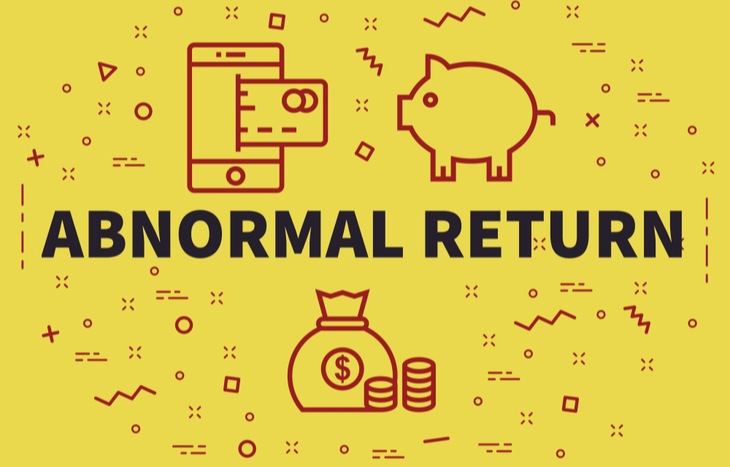What is an Abnormal Return?
When investing, it can be jarring to expect one thing, and for something completely different to happen. Specifically, when your investment shows an abnormal return. What is an abnormal return? As the name would imply, it’s a deviation from the expected rate of return, and it could go either way.
Abnormal return is a phenomenon many investors will encounter. Sometimes, you’re able to pinpoint and measure the catalyst that caused an abnormal return. Other times, market forces work mysteriously to affect returns in ways you can’t fathom. However it impacts you, it’s important to recognize an abnormal return when it occurs.

How to Spot Abnormal Returns
Abnormal returns are fairly easy to spot, but they require some context to qualify. For example, if a stock in your portfolio has a five-year trailing growth rate of 9%, then, in year six, returns 22%, it’s very clearly an abnormal return—especially if the broader market hasn’t boomed in the same way.
Most often, they occur in small increments of time—one or two days, or a week. If the market drops 2% over the course of three days and one of your stocks is up 16%, there’s clearly an abnormal return. The same goes for the inverse. If the expected growth rate of an ETF is 10% annually and you only see 3% returns, it’s an abnormal return.
And these returns don’t have to be astronomical to register. They merely need to deviate from the expected rate of return for a particular investment. To spot abnormal rates that aren’t outrageously high or low, you’ll need to have a firm grasp on the expected rate of return for each investment.
Capital Asset Pricing Model
To benchmark the expected rate of return for an asset or your portfolio, you’ll need to employ the capital asset pricing model (CAPM). The formula for CAPM is as follows:
ERi = Rf + βi (ERm – Rf)
- ERi is the expected return of investment
- Rf is the risk-free rate
- βi is the beta of the investment
- ERm is the expected return of the market
In a nutshell, CAPM takes into account the value of time (risk-free rate), the risk of an investment (beta), and the return of an investment minus the risk-free rate (risk premium). The result is a measure of expected return. Once you calculate the CAPM of an investment, you can check it against the return. For example:
Cheryl invests in ABC Company. The expected return of the market is 9%. Factor a risk-free rate of 3% and a beta of 1.5 for the company. According to CAPM calculations, the expected rate of return for ABC Company is 12%. If Cheryl’s rate of return is higher or lower by a margin, it’ll signal an abnormal return.
CAPM is useful for measuring the expected rate of return for individual securities—and useful for charting an abnormal return. Unfortunately, it won’t tell you what caused the abnormal return. To learn that, you’ll need to do some digging.
Catalysts for Abnormal Return
Many times, sudden fluctuations in price are the result of something noteworthy. Consider what happened to shares of Kodak (NYSE: KODK) from July 27, 2020 to July 29, 2020 after the company announced its foray into the pharmaceutical industry. The price shot up from $2.77 to over $60 in just two days—an abnormal return good for 1440%!
While an extreme example, Kodak’s situation shows the powerful sway certain events can have on rate of return. Lawsuits, bankruptcy, mergers and acquisitions, leadership changes, better- or worse-than-expected earnings—they all generate abnormal returns. Many traders even plan for these instances, straddling earnings calls or anticipating M&A activity to capitalize on abnormal returns.
There are, however, times when there’s no explainable reason for abnormal return. A stock might zig when the market zags. Or, it might outperform a sector for a couple of days. The reason is usually attributed to irrational investor sentiment or something obscure—the product of a market “butterfly effect.” Regardless of what causes it, abnormal returns still happen and investors still need to account for it.
Calculating Cumulative Return
Wondering what your abnormal returns amount to? It’s worth considering—especially if your portfolio is outperforming the market. Cumulative abnormal return (CAR) is a measure of the difference between actual rate of return and the expected rate of return (CAPM). Note that this is a fixed measure, which means it can apply to an instance or a time frame. For example, you might measure the CAR of a stock after one day of abnormal performance, or the CAPM of a stock at the end of the year.
Measuring CAR offers valuable insight into how much your returns account for in the scope of wealth generation. For example, if your CAR for the year is 20%, it means your investments were 20% higher than anticipated. Going forward, you’ll know to temper your expectations, since there’s likely to be a regression to the mean.
Is an Abnormal Return Good or Bad?
What is an abnormal return? On one hand, it can be a boon for your portfolio; on the other, a stroke of bad luck. The reality of these returns is that it’s merely a different outcome than what you should’ve expected. High abnormality is jarring and can unnerve you if it results in losses. Small returns might not pique your curiosity, but they’re nevertheless important to consider.
Having the skill to calculate CAPM and CAR will give you confidence as you consider the true performance of your investments, and what to expect in the future. In addition, you can discover the latest investment patterns and stock market analysis with the experts at Investment U. Sign up for our FREE e-letter below for immediate access.





